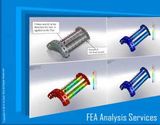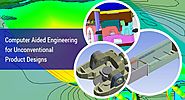-
About
- About Listly
- Community & Support
- Howto
- Chrome Extension
- Bookmarklet
- WordPress Plugin
- Listly Premium
- Privacy
- Terms
- DMCA Copyright
- © 2010-2025 Boomy Labs


 Bhaumik Dave
Bhaumik Dave
Listly by Bhaumik Dave
Hi-tech FEA is Leading FEA Consulting service provider firm offering FEA Analysis services, Static & Dynamic, Vibration, Fatigue, Coupled Field Analysis services at low cost.
Material selection is one of the crucial aspects of a product design. It defines the look as well as the performance of a product. Material of a product has a major share in defining the attributes such as durability, robustness and glamour quotient.
Finite element analysis experts use advanced simulation techniques to evaluate and validate the strength, durability and reliability and hence the performance of a product. Implementing FEA, early in the design phase, helps engineers design a product for the best performance.
Thermal analysis is the extent of speculation about how thermal performance of a design gets changed with temperature. Basically there are three mode of heat transfer which thermal analysis covers to study the effect over a particular body- Conduction, Convection and Radiation.
Thermal analysis is the second most common analysis performed by engineers to evaluate the product design involving the generation, storage or exchange of heat. here’s a list of points you should follow to avoid pitfalls while performing thermal analysis using finite element approach.

There's nothing new about utilizing finite element analysis to evaluate automotive component designs for structural, thermal and fatigue strengths. However, with modern solver capabilities, taking a deeper dive into vehicular development using finite element analysis is possible. Today, software capabilities are not simply restricted to calculating stress and deformation characteristics of the component, but can be utilized to uncover wealth of information.

The purpose of pressure vessels is to store gases and liquids at pressure range different from ambient conditions. Selecting a pressure vessel for specific application requires understanding the internal pressure conditions that generate forces on the walls of the vessels that subsequently generate stress and deformation.

Modern automobile engines are required to face numerous challenges apart from its ability to churn out maximum power through efficient fuel burning.

Design for sustainability, is the priority for most modern day organizations. Hence applying FEA capabilities to achieve sustainability goals has become popular. However, in order to conduct finite element analysis and design for higher sustainability, it is essential to define sustainability goals.
Finite Element Analysis (FEA) is a technique normally conducted by software to produce models of materials or designs that can then be subjected to virtual stresses.

Finite Element Analysis is one of the efficient methods to comprehensively evaluate engineering products for strength, reliability and useful life cycle. Most engineering devices developed today, make use of computational tools to perform finite element analysis before being physically tested.

Finite element analysis is a numerical approach to evaluate solid mechanics problems. Today, most engineers utilize this approach as a means to assess the product design performance. FEA however requires creating a mathematical model from the CAD model by defining the geometry, loads and constraints along with the type of analysis required to be performed such as structural or thermal.




Finite Element Analysis (FEA) is an essential aspect of product design in most industry sectors. In spite FEA being so important manufacturers don’t focus on it much or sometimes ignore it. And ultimately end up with inefficient product design and later tend to pay more for FEA analysis and product design optimization.

The results of finite element analysis hugely depend on the type of element used to convert the geometry into smaller elements. While in most 3D simulations, solid elements are required, it is found that these elements do not give desired results for thin and slender structures.

Finite element analysis has made lives of mechanical engineers and design engineers a lot easier. Through simulation techniques, evaluating product designs have become faster, allowing manufacturers to reach their product development goals on time and place their products in the market effectively.

Any engineered product’s success rate hugely depends on the amount of useful life it delivers. As conventional designs continue evolving for the sake of improving performance, it has become mandatory for design engineers to adopt new ways to determine and increase product life, while downsizing and reducing the development cost.

Products are getting smarter every day, and are becoming more personalized and largely different from conventional designs. The modern engineering community as such has to rely on new set of design and development tools against the conventional ones.

Finite element analysis has always been used as a third dimension in product testing apart from experimental and analytical tests. The reason why FEA alone is not employed as a standard testing tool is primarily because it is an approximation of the partial differential equations and often consists of residuals that always keep the results from being 100% accurate.
